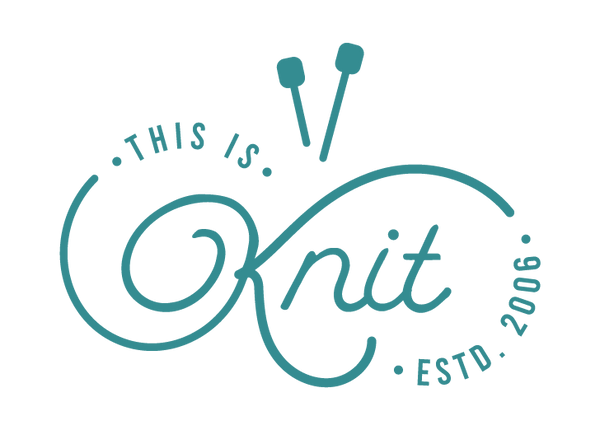Starting with just one stitch
July 18 2014 – thisisknit
 Part of the fun of a KAL is finding out new ways of doing things. Our HapKAL means that we're all hearing about different techniques, because there's lots of different patterns being used. Over the next couple of weeks we'll feature picture tutorials for several of the techniques involved, and today's the first of these.
Hap patterns often have the centre made on the bias, starting with a very tiny number of stitches in one corner, increasing until the full width of the diagonal is reached, and then decreasing back down to the opposite corner. This gives a very elastic and stretchy fabric for snuggling into. And the smallest number you can start with is just one. So that's what we're going to show you here: how to cast on only stitch and increase from it.
The picture up above shows where to start: make a slip knot and pop it onto the left hand needle, and take up the other needle in your right hand, just as if you were going to knit.
Put the tip of the right hand needle into the single loop, again just like a knit stitch.
Part of the fun of a KAL is finding out new ways of doing things. Our HapKAL means that we're all hearing about different techniques, because there's lots of different patterns being used. Over the next couple of weeks we'll feature picture tutorials for several of the techniques involved, and today's the first of these.
Hap patterns often have the centre made on the bias, starting with a very tiny number of stitches in one corner, increasing until the full width of the diagonal is reached, and then decreasing back down to the opposite corner. This gives a very elastic and stretchy fabric for snuggling into. And the smallest number you can start with is just one. So that's what we're going to show you here: how to cast on only stitch and increase from it.
The picture up above shows where to start: make a slip knot and pop it onto the left hand needle, and take up the other needle in your right hand, just as if you were going to knit.
Put the tip of the right hand needle into the single loop, again just like a knit stitch.
 Wrap the yarn around the tip of the right hand needle (again, just like a knit stitch):
Wrap the yarn around the tip of the right hand needle (again, just like a knit stitch):
 Pull a new loop of yarn out of the stitch on the left hand needle (yes, just like when you're half way through a knit stitch!). But then, don't let the old stitch drop the left hand needle. You want to keep it on the needle because you're not finished with it yet.
Pull a new loop of yarn out of the stitch on the left hand needle (yes, just like when you're half way through a knit stitch!). But then, don't let the old stitch drop the left hand needle. You want to keep it on the needle because you're not finished with it yet.
 Move the tip of the right hand needle towards the back of the stitch on the left. You'll see a little gap between the back leg of that stitch and the needle.
Move the tip of the right hand needle towards the back of the stitch on the left. You'll see a little gap between the back leg of that stitch and the needle.
 Poke the tip of your right hand needle into that gap...
Poke the tip of your right hand needle into that gap...
 ...and wrap the yarn around the tip of the right hand needle, pulling a new stitch out in the usual way.
And there you are - you've made two stitches from a cast on of just one. When you increase by just one stitch at the beginning of every row, you end up with a right-angled triangle, so your increase rate is bang on from the very first row.
...and wrap the yarn around the tip of the right hand needle, pulling a new stitch out in the usual way.
And there you are - you've made two stitches from a cast on of just one. When you increase by just one stitch at the beginning of every row, you end up with a right-angled triangle, so your increase rate is bang on from the very first row.
 The next thing is to work those increases on subsequent rows. There's more than one way of doing that, and there's advantages and disadvantages to all of them. You'll find details of one of them, with yarn overs right at the beginning of the row, in our next blog post.
Of course, if you've got a technique question that we can help you with, leave a comment below and we'll do out best to help!
The next thing is to work those increases on subsequent rows. There's more than one way of doing that, and there's advantages and disadvantages to all of them. You'll find details of one of them, with yarn overs right at the beginning of the row, in our next blog post.
Of course, if you've got a technique question that we can help you with, leave a comment below and we'll do out best to help!

0 comments